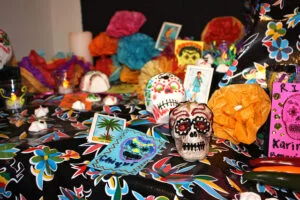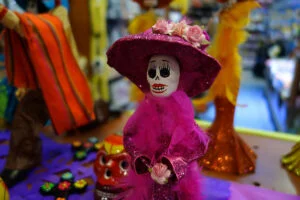While Halloween is a well-known holiday celebrated in many Western countries, Mexico has its own unique and vibrant tradition called Día de Muertos (Day of the Dead). Although these two holidays occur around the same time, they differ significantly. In this article, we will explore the origins, meaning, and customs of this important Mexican holiday. Join us as we delve into the rich cultural heritage of Día de Muertos.
History

Día de Muertos is believed to have ancient roots that trace back thousands of years to an Aztec festival dedicated to Mictecacihuatl, the goddess of the underworld, also known as the “Lady of the Dead.” Originally held in August according to the Aztec calendar, the holiday later shifted to align with the Christian Allhallowtide at the end of October due to Spanish colonization.
Meaning
Día de Muertos is a multi-day holiday that serves as a joyful remembrance and tribute to the deceased. Rather than a somber occasion, it is a celebration of the lives and memories of loved ones. The festivities are vibrant and colorful, earning this traditional holiday a place on UNESCO’s Intangible Cultural Heritage of Humanity list in 2008.
According to belief, the gates of heaven open at midnight on November 1st, allowing the spirits of deceased children to return and reunite with their families. Hence, this day is known as “Día de los Inocentes” (Day of the Innocents) or “Día de los Angelitos” (Day of the Little Angels). The following day, the spirits of adults join the celebration.
Learn more about the Day of the Dead in this great video.
Customs
Día de Muertos encompasses numerous customs and traditions that make it one of Mexico’s most significant holidays. Families invest considerable time and resources to prepare for this occasion. They visit cemeteries to clean and adorn the graves of their loved ones. The preferred flowers for decoration are cempasúchil, also known as “Flor de Muerto” (Flower of the Dead) or Mexican marigolds. Some families create a path of flower petals from the graves to their homes to guide the spirits’ return. In a touching gesture, many families even spend the night in cemeteries, sharing stories and jokes in remembrance of the departed.

Building an altar, known as an “ofrenda,” is one of the most prominent traditions during the Day of the Dead. These altars are adorned with flowers, incense, candles, photographs, and other meaningful objects. The departed are honored with their own bread called “pan de muerto,” a sweet bread often shaped like bones. Children’s spirits receive toys, while adults are offered cigarettes or mezcal. The ofrendas serve as a warm welcome to the spirits, paying homage to their presence.
Families put great effort into creating elaborate ofrendas, sometimes allocating up to two months’ worth of income for the festival’s preparation. It is believed that honoring the deceased provides protection and brings good luck, making it a worthwhile investment. Neglecting to honor the dead is thought to potentially bring about illness or misfortune.
In a celebration that revolves around the deceased, it is unsurprising to see an abundance of calaveras (skulls) and calacas (skeletons). Throughout Mexico, people craft or purchase intricate “calaveras de alfeñique” (sugar skulls) for the festival. However, these sugary delights are not meant to be eaten like gingerbread men. The name of the departed is often inscribed on the forehead of the skull, which is then placed on the ofrenda.

Among the famous symbols associated with this holiday is “La Calavera Catrina” (the Elegant Skull). Illustrated by José Guadalupe Posada, this character satirized Mexicans, particularly politicians and the upper class, who aspired to emulate European culture. Diego Rivera later immortalized her in his mural titled “Sueño de una Tarde Dominical en la Alameda Central” (Dream of a Sunday Afternoon Along Central Alameda). La Calavera Catrina has become an iconic representation of the Day of the Dead and can be found throughout the country in various artistic interpretations.
A more contemporary addition to the festivities is the Day of the Dead parade in Mexico City, popularized by the James Bond film “Spectre.” Inspired by this depiction, the city decided to organize its own grand parade.
See some highlights from the first massive Day of the Dead parade in Mexico City.
Día de Muertos and its associated customs provide a unique perspective on how to celebrate life rather than mourn death. As individuals in many countries participate in Halloween activities, let us also appreciate the colorful and joyous celebration next door. The Day of the Dead serves as a valuable cultural lesson, offering insights into different ways of contemplating and embracing mortality.




